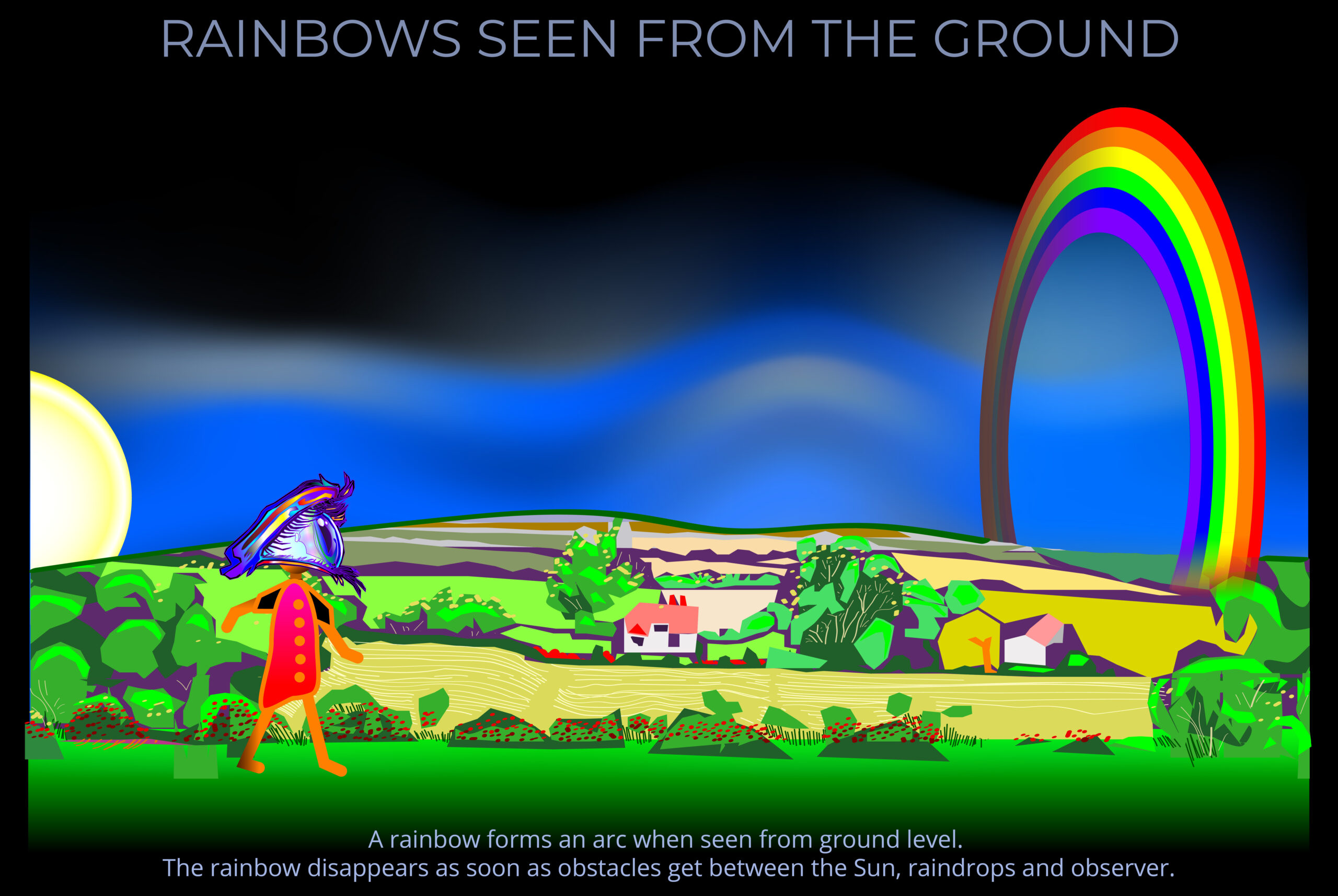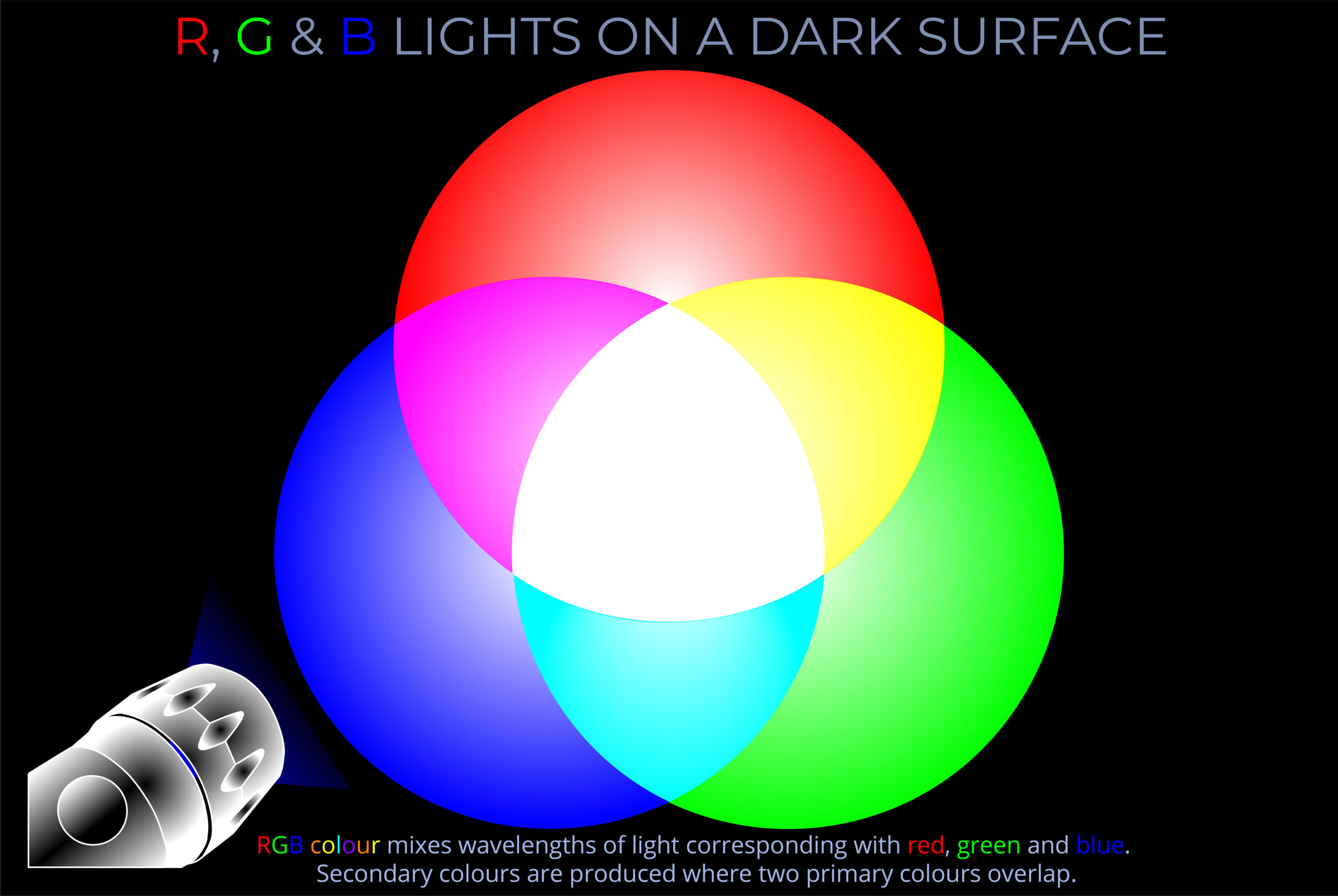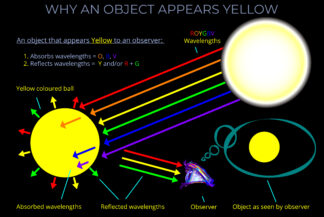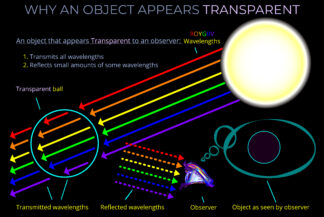Rainbows Seen From the Ground
£0.00
This is one of a set of almost 40 diagrams exploring Rainbows.
Each diagram appears on a separate page and is supported by a full explanation.
- Follow the links embedded in the text for definitions of all the key terms.
- For quick reference don’t miss the summaries of key terms further down each page.
Description
Rainbows Seen From the Ground
TRY SOME QUICK QUESTIONS AND ANSWERS TO GET STARTED
About the Diagram
An overview of rainbows
About the diagram: Atmospheric rainbow summary
Visual processing
Visual processing is a complex and dynamic process that involves interactions between various retinal cells, neural pathways, and brain regions, ultimately leading to conscious visual perception.
Visual processing begins the moment light enters the human eye. It then progresses through multiple stages as signals travel towards the visual cortex, where the neural activity is integrated, resulting in conscious visual experience.
As visual processing begins the retina starts to process information about colors, as well as basic information about the shape and movement associated with those colors. By the end of this stage, multiple forms of information about a visual scene are ready to be conveyed to higher brain regions.
Let’s examine two major forms of processing, trichromatic and opponent-processing, which occur within the eyeball as visual information is gathered from light entering our eyes.
Trichromacy, also known as the trichromatic theory of colour vision, explains how three types of cone receptors in the retina work together with bipolar cells to perform their role in the initial stage of colour processing. Rod cells also play a significant role in this form of processing visual information, particularly in low-light conditions.
Opponent-processing, also known as the opponent-process theory of colour vision, explains the second form of processing. Opponent-processing involves ganglion cells that process the data received from trichromatic processing and combine it with other intercellular activities.
It is interesting to note that as both trichromatic and opponent-process theories developed over the last century, researchers and authors have often pitted one theory against the other. However, both processes are crucial for understanding how colour vision occurs.
Trichromatic theory explains the encoding of visual information when light hits the retina, while opponent-processing explains a subsequent stage of information convergence, assembly, and coding before the data leaves the retina via the optic nerve.
Note that:
- Both trichromatic and opponent-processing occur independently within each retina, without comparing with the other.
- Each eye gathers information from a specific viewpoint, approximately 50 mm to the left or right of the nose.
- The two impressions are later compared and combined to provide us with a single three-dimensional, stereoscopic view of the world, rather than two flattened images.
We can consider the layers of retinal cells involved in trichromatic and opponent-processing as examining, interpreting, and transmitting visually relevant information. However, it would be incorrect to view this as a straightforward linear process due to the intricate neural networking, cross-referencing, and feedback loops within the retina.
Some Key Terms
White light is the term for visible light that contains all wavelengths of the visible spectrum at equal intensities.
- The sun emits white light because sunlight contains all the wavelengths of the visible spectrum in roughly equal proportions.
- Light travelling through a vacuum or a medium is termed white light if it includes all wavelengths of visible light.
- Light travelling through a vacuum or air is not visible to our eyes unless it interacts with something.
- The term white light can have two meanings:
- It can refer to a combination of all wavelengths of visible light travelling through space, regardless of observation.
- What a person sees when all colours of the visible spectrum hit a white or neutral-coloured surface.
Visible light refers to the range of wavelengths of electromagnetic radiation that is perceived as colour by human observers. While the range of visible light is generally considered to be 400-700 nm, the exact range of colours perceptible can vary slightly between individuals.
- Visible light is one form of electromagnetic radiation. Other forms of electromagnetic radiation include radio waves, microwaves, infrared, ultraviolet, X-rays, and gamma rays. Visible light ranges from approximately 400 nanometres (nm) for violet to 700 nm for red.
- A human observer perceives visible light as a combination of all the spectral colours between red and violet, as well as a vast range of other colours produced from the blending of different wavelengths in varying proportions.
The visible part of the electromagnetic spectrum is called the visible spectrum.
- The visible spectrum is the range of wavelengths of the electromagnetic spectrum that correspond with all the different colours we see in the world.
- As light travels through the air it is invisible to our eyes.
- Human beings don’t see wavelengths of light, but they do see the spectral colours that correspond with each wavelength and colours produced when different wavelengths are combined.
- The visible spectrum includes all the spectral colours between red and violet and each is produced by a single wavelength.
- The visible spectrum is often divided into named colours, though any division of this kind is somewhat arbitrary.
- Traditional colours referred to in English include red, orange, yellow, green, blue, and violet.
A rainbow is an optical effect produced by illuminated droplets of water. Rainbows are caused by reflection, refraction (bending) and dispersion (spreading out) of light in individual droplets and result in the appearance of an arc of spectral colours.
- Atmospheric rainbows only appear when weather conditions are ideal and an observer is in the right place at the right time.
- Waterfalls, lawn sprinklers and other things that produce air-borne water droplets can produce a rainbow.
- An atmospheric rainbow is formed from countless individual droplets each of which reflects and refracts a tiny coloured image of the Sun towards the observer.
- As white light passes through water droplets, refraction causes the light to disperse and separate into the different colours seen by an observer.
- If the sun is behind an observer then the rainbow will appear in front of them.
- When a rainbow is produced by sunlight, the angles between the sun, each droplet and the observer determine which ones will form part of the rainbow, the colour each droplet will produce and the sequence in which they appear.
Colour is not a property of electromagnetic radiation, but a feature of visual perception by an observer.
- The human eye and so human visual perception are tuned to the visible spectrum and so to spectral colours between red and violet.
- There are no properties of electromagnetic radiation that distinguish visible light from other parts of the electromagnetic spectrum.
- Objects appear to be different colours to an observer depending on the wavelengths, frequencies and amplitude of visible light at the moment it strikes the retina at the back of the eye.
A human observer is a person who engages in observation by watching things.
- In the presence of visible light, an observer perceives colour because the retina at the back of the human eye is sensitive to wavelengths of light that fall within the visible part of the electromagnetic spectrum.
- The visual experience of colour is associated with words such as red, blue, yellow, etc.
- The retina’s response to visible light can be described in terms of wavelength, frequency and brightness.
- Other properties of the world around us must be inferred from light patterns.
- An observation can take many forms such as:
- Watching an ocean sunset or the sky at night.
- Studying a baby’s face.
- Exploring something that can’t be seen by collecting data from an instrument or machine.
- Experimenting in a laboratory setting.
Vision, the human visual system, is a complex interplay between various components of the eye, including the cornea, pupil, lens, iris, retina, and optic nerve. It collaborates to capture, focus, and convert light into electrical signals that are transmitted to the brain for visual processing and interpretation.
- Vision begins when light emitted or reflected by an object or scene enters our eyes through the cornea, pupil, and lens.
- The cornea and the lens work together to concentrate and focus light onto the retina, which is the photosensitive layer of cells at the back of the eyeball.
- The iris, located between the cornea and the lens, regulates the amount of light reaching the retina. It also determines eye colour and controls the size of the pupil.
- The retina plays a vital role in converting differences in the wavelength and brightness of incoming light into electrical signals.
- The optic nerve, which exits at the back of the eye, carries these signals to the visual processing areas of the brain.
- The observer effect is a principle of physics and states that any interaction between a particle and a measuring device will inevitably change the state of the particle. This is because the act of measurement itself imposes a disturbance on the particle’s wave function, which is the mathematical description of its state.
- The concept of observation refers to the act of engaging with an electron or other particle, achieved through measuring its position or momentum.
- In the context of quantum mechanics, observation isn’t a passive undertaking, observation actively alters a particle’s state.
- This means that any kind of interaction with an atom, or with one of its constituent particles, that provides insight into its state results in a change to that state. The act of observation is always intrusive and will always change the state of the object being observed.
- It can be challenging to reconcile this with our daily experience, where we believe we can observe things without inducing any change in them.
Visual perception is the human ability to see and understand our surroundings by virtue of the sensitivity of our eyes to wavelengths of light across the entire visible spectrum, from red to violet.
- Visual perception is a complex process that relies on the intricate interaction between our eyes, the brain, and the interpretation of light signals. It enables us to perceive various visual attributes such as shapes, sizes, textures, depths, motions, and spatial relationships, all of which contribute to our comprehensive understanding and interpretation of the visual world around us.
A light source is a natural or man-made object that emits one or more wavelengths of light.
- The Sun is the most important light source in our lives and emits every wavelength of light in the visible spectrum.
- Celestial sources of light include other stars, comets and meteors.
- Other natural sources of light include lightning, volcanoes and forest fires.
- There are also bio-luminescent light sources including some species of fish and insects as well as types of bacteria and algae.
- Man-made light sources of the most simple type include natural tars and resins, wax candles, lamps that burn oil, fats or paraffin and gas lamps.
- Modern man-made light sources include tungsten light sources. These are a type of incandescent source which means they radiate light when electricity is used to heat a filament inside a glass bulb.
- Halogen bulbs are more efficient and long-lasting versions of incandescent tungsten lamps and produce a very uniform bright light throughout the bulb’s lifetime.
- Fluorescent lights are non-incandescent sources of light. They generally work by passing electricity through a glass tube of gas such as mercury, neon, argon or xenon instead of a filament. These lamps are very efficient at emitting visible light, produce less waste heat, and typically last much longer than incandescent lamps.
- An LED (Light Emitting Diode) is an electroluminescent light source. It produces light by passing an electrical charge across the junction of a semiconductor.
- Made-made lights can emit a single wavelength, bands of wavelengths or combinations of wavelengths.
- An LED light typically emits a single colour of light which is composed of a very narrow range of wavelengths.



